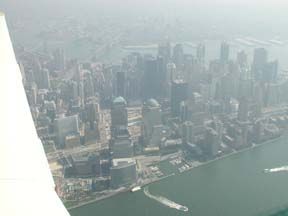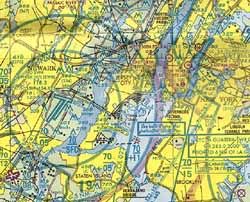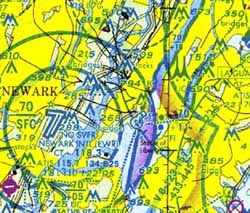While we’ll concede the presidential TFR over Kennebunkport, Maine, last weekend was breathtakingly excessive — any chance we could fly over some of the state? — the consolation is that, with the cancellation of the Statue of Liberty TFR, the New York Hudson corridor is back to normal. AVweb’s Paul Bertorelli flew it last week, and it’s as inspiring as ever, even if what’s missing gives us sad pause.
As any cynic will tell you, once the government wriggles away one of your cherished personal rights, you’re not likely to get it back. Ever. Or so goes the conventional wisdom from those staunch defenders of all that free men hold dear.
Then again, sometimes the conventional wisdom is wrong, as it was last week when I did something I never expected to do again: I flew the Hudson VFR corridor from the Tappan Zee, through midtown Manhattan, past the Statue of Liberty and across New York Bay at 1,500 feet.
A year and a half ago, that was a routine flight for me on frequent jaunts down the east coast to New Jersey and points south. It was — and remains — one of the most spectacular flights any GA pilot can make; there is no better way to see New York City than from 1,500 feet over the Hudson.
All that ended on September 11, 2001, of course. What had been a free ride through some of the busiest airspace in the country was sealed up tighter than a steel drum and patrolled by Air Force F-16s and Army Blackhawks to keep it that way.
I’m sure that most of us in the New York area accepted that the VFR corridor was a thing of the past, and we went about the business of finding other ways to circumnavigate the city. I don’t recall hearing a single serious complaint about the demise of the corridor, likely because whining about it would seem trivial given the enormity of the tragedy in lower Manhattan.
Yet slowly, like Phoenix from the ashes, the corridor came back. During the spring, a friend who flies helicopter charters told me he was transiting the corridor daily, from the Jersey side to Westchester. Surely he’s mistaken, I thought, since the Ground Zero TFR was still in effect for a three-mile radius. But no, by special arrangement and with specific clearances, some operators were resuming operations in the corridor.
Linden Airport, a nice little field hard by Newark, was operating again, after being made all but inaccessible last September.
By midsummer, the Ground Zero TFR was gone, although another existed around the Statue of Liberty that made navigating the corridor a little too tight to bother with. And then, one day and without ceremony, all those restrictions were gone, almost as if it had all been a bad dream.
Yet confusion lingers. Before departing last Wednesday, I briefed up carefully on DUATS, then called Flight Service for one last check of TFRs. Was the Statue TFR gone?
“No,” said the briefer, “I don’t think so. Let me check. Well … yeah, I guess it is. I can’t find it.”
Does that then mean, I asked, that the corridor is back to normal, just the way it was prior to 9/11?
“Oh, I don’t know about that. I couldn’t say for sure,” he said. Who would know then? He couldn’t suggest who to ask. I’ve been around the houses enough times to know never to rely on Flight Service for the last word on anything, but still, it begs the question: This is a system? No matter. I’m not grounded. I can cope with it.
What the hell, I figured, let’s push to test.
- The Statue of Liberty TFR expired on September 30 and wasn’t reissued. That appears not to be an oversight.
- Carefully check TFR status before flying the corridor. It can change by the hour, especially if POTUS is in town.
- For all intents, the Hudson River VFR corridor is back to pre-9/11 status, meaning you can transit the airspace with neither ATC advisories nor clearance below 1,100 feet from the Verrazano Bridge northbound and from the Alpine Tower southbound. (Self-announce traffic advisories on 123.05.)
- Call us chicken, but we wouldn’t fly the corridor zip-lip just yet. Getting ATC advisories can’t hurt, and if a surprise TFR pops up, better to find out about it from a controller than a Blackhawk pilot.
- ATC frequencies in use for advisories are 126.4 north, in the Westchester area, 126.05 for LaGuardia tower, 127.85 for Newark tower near the GWB, and 132.8 for New York approach near the Verrazano.
- Last, as our friends at AOPA say, “Fly responsibly.” That’s a polite way of saying don’t do anything stupid, which includes buzzing the Statue or overflying Ground Zero for a better look. You know what to do.
I launched VFR from home base at Oxford, Conn., raised New York approach on 126.4 over Carmel — that’s a VOR 32 miles northeast of LaGuardia — and asked for a Class-B clearance down the Hudson at 2,000 feet, fully expecting the standard New York controller response to a prayer: “You wanna do what?” (The merciful ones unkey the mike to mask the gales of laughter in the background.)
Not this time: “Proceed as requested. You want handoffs or do it on your own at 1,000 feet?” Momentarily caught off balance, the Marlboro Man fell off his mount; I declined the heroics and took the handoffs, first to LaGuardia tower, then Newark, then back to New York approach past Battery Park. Except for one ATC frequency failing into a blizzard of static — business as usual around these parts — the flight was uneventful. I will admit to some tension.
From the air, I have only known New York defined by the twin towers anchoring the south end of Manhattan. They have always provided a sense of range, marking the point at which you’re about to go feet wet over the bay on the short overwater run to Sandy Hook, N.J., leaving the city behind.
It is distinctly disorienting to have them gone; the midtown skyline from abeam the George Washington Bridge is reassuringly familiar, but everything south of the 40s is now a jumble of indistinct buildings that fade into Upper New York Bay. On the Jersey side, there’s a tall high rise — still rising — that wasn’t there 14 months ago.
As for Ground Zero itself, for a patch of land that has been the focus of so much shared pain, it is, in the end, an unremarkable sight from the air. But perhaps the eye sees what the mind cannot accept; at 150 knots, it appears briefly as a fresh-cut gash in the Manhattan rock, clear of rubble, dotted with heavy equipment, and only the slightest sense that it’s a multi-tiered, vast hole in the ground. Although no one is buried there, it is a gravesite, nonetheless. There is little time to ponder, however, for it slides past the wing and is gone.
With the anniversary of 9/11 a month behind us, I had wondered if we would ever lift ourselves out of the mire of memorializing what we can’t change and resurrect the forward-looking confidence that makes this country the kind of place where you can still window-shop in the greatest city in the world from the cockpit of a little airplane. I guess I got my answer last week.
Everyone has a different perspective, I suppose, but dwelling in the realm of aviation as I do daily, I grow weary of the hand-wringing and fretting over how things will never be the same as they were, and how the government has flat-out taken the fun out of flying. If I hear another clich about slippery slopes, I fear I’ll vomit.
Yes, you have to play hide-and-seek with a few TFRs and fool around with some local security restrictions, and you can’t get back into DCA in a spam can just yet. We’re still working on that one. Personally, I’m happy to take the little victories one at a time. (No illusions of governmental beneficence here; a tip of the hat to the alphabet groups who fight the good fight.)
Yet this simple, little, inconsequential flight down the Hudson River over landmarks I’ve known for years makes me certain we’ve arrested the short-term habit of looking only to the rear. We’ll get over 9/11’s impact on aviation if we let ourselves.
Next time you’re in the New York vicinity, take a flight down the Hudson corridor and you’ll see what I mean.
About the author…
Paul Bertorelli is a professional aviation journalist and editor. He’s Editor in Chief of The Aviation Consumer and editorial director of AVweb and Belvoir Publications’ Aviation division. He’s a 4,500-hour ATP and CFIA/CFII/CFIME. He owns a Mooney 231.





































